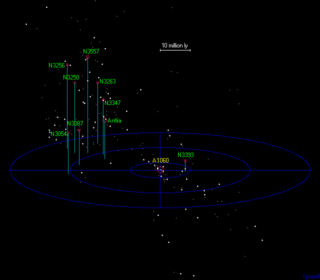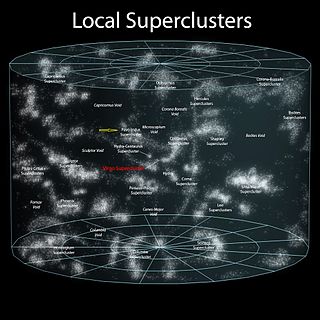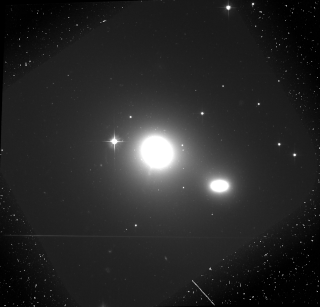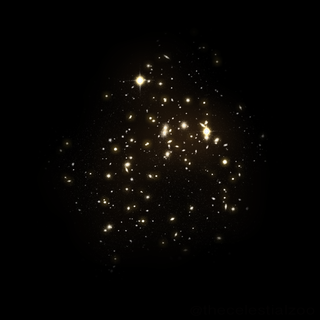Related Research Articles

Corona Borealis is a small constellation in the Northern Celestial Hemisphere. It is one of the 48 constellations listed by the 2nd-century astronomer Ptolemy, and remains one of the 88 modern constellations. Its brightest stars form a semicircular arc. Its Latin name, inspired by its shape, means "northern crown". In classical mythology Corona Borealis generally represented the crown given by the god Dionysus to the Cretan princess Ariadne and set by her in the heavens. Other cultures likened the pattern to a circle of elders, an eagle's nest, a bear's den or a smokehole. Ptolemy also listed a southern counterpart, Corona Australis, with a similar pattern.

A supercluster is a large group of smaller galaxy clusters or galaxy groups; they are among the largest known structures in the universe. The Milky Way is part of the Local Group galaxy group, which in turn is part of the Virgo Supercluster, which is part of the Laniakea Supercluster, which is part of the Pisces–Cetus Supercluster Complex. The large size and low density of superclusters means that they, unlike clusters, expand with the Hubble expansion. The number of superclusters in the observable universe is estimated to be 10 million.

The Virgo Supercluster or the Local Supercluster was a formerly defined supercluster containing the Virgo Cluster and Local Group, which itself contains the Milky Way and Andromeda galaxies, as well as others. At least 100 galaxy groups and clusters are located within its diameter of 33 megaparsecs. The Virgo SC is one of about 10 million superclusters in the observable universe and is in the Pisces–Cetus Supercluster Complex, a galaxy filament.

The Great Attractor is a region of gravitational attraction in intergalactic space and the apparent central gravitational point of the Laniakea Supercluster of galaxies that includes the Milky Way galaxy, as well as about 100,000 other galaxies.

The Hydra–Centaurus Supercluster, or the Hydra and Centaurus Superclusters, was a previously defined supercluster in two parts, which prior to the identification of Laniakea Supercluster in 2014 is the closest neighbour of the former Virgo Supercluster. Its center is located about 39 Mpc (127 Mly) away, with it extending to a maximum distance of around 69 Mpc (225 Mly).

The Hydra Cluster is a galaxy cluster that contains 157 bright galaxies, appearing in the constellation Hydra. The cluster spans about ten million light-years and has an unusually high proportion of dark matter. The cluster is part of the Hydra–Centaurus Supercluster located 158 million light-years from Earth. The cluster's largest galaxies are elliptical galaxies NGC 3309 and NGC 3311 and the spiral galaxy NGC 3312 all having a diameter of about 150,000 light-years. In spite of a nearly circular appearance on the sky, there is evidence in the galaxy velocities for a clumpy, three-dimensional distribution.

The Pavo–Indus Supercluster is a neighboring supercluster located about 60–70 Mpc (196–228 Mly) away in the constellations of Pavo, Indus, and Telescopium. The supercluster contains three main clusters, Abell 3656, Abell 3698, and Abell 3742.

3C 66B is an elliptical Fanaroff and Riley class 1 radio galaxy located in the constellation Andromeda. With an estimated redshift of 0.021258, the galaxy is about 300 million light-years away.

In cosmology, galaxy filaments are the largest known structures in the universe, consisting of walls of galactic superclusters. These massive, thread-like formations can commonly reach 50/h to 80/h Megaparsecs —with the largest found to date being the Hercules-Corona Borealis Great Wall at around 3 gigaparsecs (9.8 Gly) in length—and form the boundaries between voids. Due to the accelerating expansion of the universe, the individual clusters of gravitationally bound galaxies that make up galaxy filaments are moving away from each other at an accelerated rate; in the far future they will dissolve.

The Hercules Superclusters refers to a set of two nearby superclusters of galaxies.

The Laniakea Supercluster or the Local Supercluster is the galaxy supercluster that is home to the Milky Way and approximately 100,000 other nearby galaxies.

The Corona Borealis Supercluster is a supercluster located in the constellation Corona Borealis and the most prominent example of its kind in the Northern Celestial Hemisphere. Dense and compact compared with other superclusters, its mass has been calculated to lie somewhere between 0.6 and 12 × 1016 solar masses (M⊙). It contains the galaxy clusters Abell 2056, Abell 2061, Abell 2065 (the most massive galaxy cluster within the supercluster), Abell 2067, Abell 2079, Abell 2089, and Abell 2092. Of these, Abell 2056, 2061, 2065, 2067 and A2089 are gravitationally bound and in the process of collapsing to form a massive cluster. This entity has an estimated mass of around 1 × 1016 M⊙. If there is inter-cluster mass present, then Abell 2092 may also be involved. It has been estimated to be 100 megaparsecs (330 million light-years) wide and 40 megaparsecs (130 million light years) deep. It has a redshift of 0.07, which is equivalent to a distance of around 265.5 megaparsecs (964 million light-years).

Abell 2065 is a highly concentrated galaxy cluster in the constellation of Corona Borealis containing over 400 member galaxies, the brightest of which are 16th magnitude. The cluster is more than one billion light-years from Earth. On a larger scale still, Abell 2065, along with Abell 2061, Abell 2067, Abell 2079, Abell 2089, and Abell 2092, make up the Corona Borealis Supercluster.
Abell 2061 is a galaxy cluster in the constellation of Corona Borealis. On a larger scale still, Abell 2061, along with Abell 2065, Abell 2067, Abell 2079, Abell 2089, and Abell 2092, make up the Corona Borealis Supercluster. It has a northeast southwest orientation and Abell 2067 lies 1.8 megaparsecs north of it.
The Microscopium Supercluster is a supercluster located in the constellation Microscopium. First noticed in the early 1990s, it has received little study. It is composed of Abell clusters 3695 and 3696, while the relations of Abell clusters 3693 and 3705 in the same field are unclear.
Abell 2162 is a galaxy cluster in the Abell catalogue located in the constellation Corona Borealis. It is a member of the Hercules Superclusters, the redshifts of the member galaxies of which lie between 0.0304 and 0.0414. The cluster hosts a massive Type-cD galaxy called NGC 6086.

NGC 6120 is a peculiar spiral galaxy located roughly 440 million light-years away from the Sun. It is located in the northern constellation of Corona Borealis, and is a member of the Abell 2199 galaxy cluster.

NGC 708 is an elliptical galaxy located 240 million light-years away in the constellation Andromeda and was discovered by astronomer William Herschel on September 21, 1786. It is classified as a cD galaxy and is the brightest member of Abell 262. NGC 708 is a weak FR I radio galaxy and is also classified as a type 2 Seyfert galaxy.
References
- ↑ Pearson, David W.; Batiste, Merida; Batuski, David J. (2014). "The Largest Gravitationally Bound Structures: The Corona Borealis Supercluster - Mass and Bound Extent". Mon. Not. R. Astron. Soc. 441 (2): 1601–1614. arXiv: 1404.1308 . Bibcode:2014MNRAS.441.1601P. doi: 10.1093/mnras/stu693 .
- ↑ Postman, M.; Geller, M. J.; Huchra, J. P. (1988). "The dynamics of the Corona Borealis supercluster". Astronomical Journal. 95: 267–83. Bibcode:1988AJ.....95..267P. doi:10.1086/114635.
- ↑ van Weeren, R. J.; Brüggen, M.; Röttgering, H. J. A.; Hoeft, M.; Nuza, S. E.; Intema, H. T. (2011). "Radio continuum observations of new radio halos and relics from the NVSS and WENSS surveys. Relic orientations, cluster X-ray luminosity, and redshift distributions". Astronomy & Astrophysics. 533 (A35): 20. arXiv: 1107.5597 . Bibcode:2011A&A...533A..35V. doi:10.1051/0004-6361/201117149. S2CID 55747728.